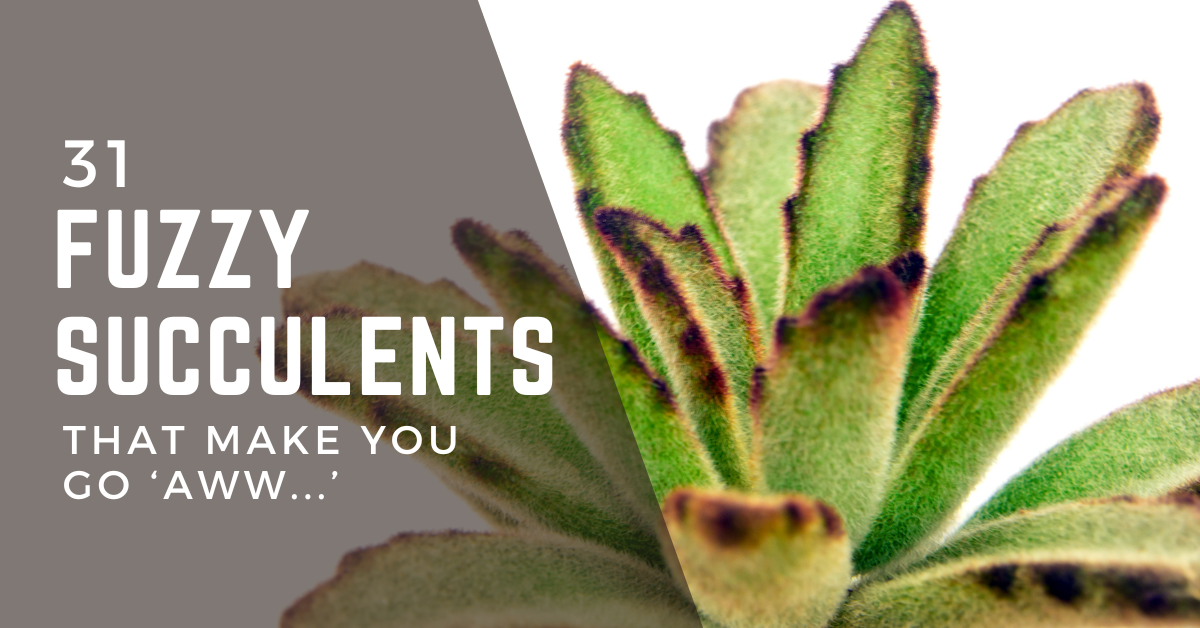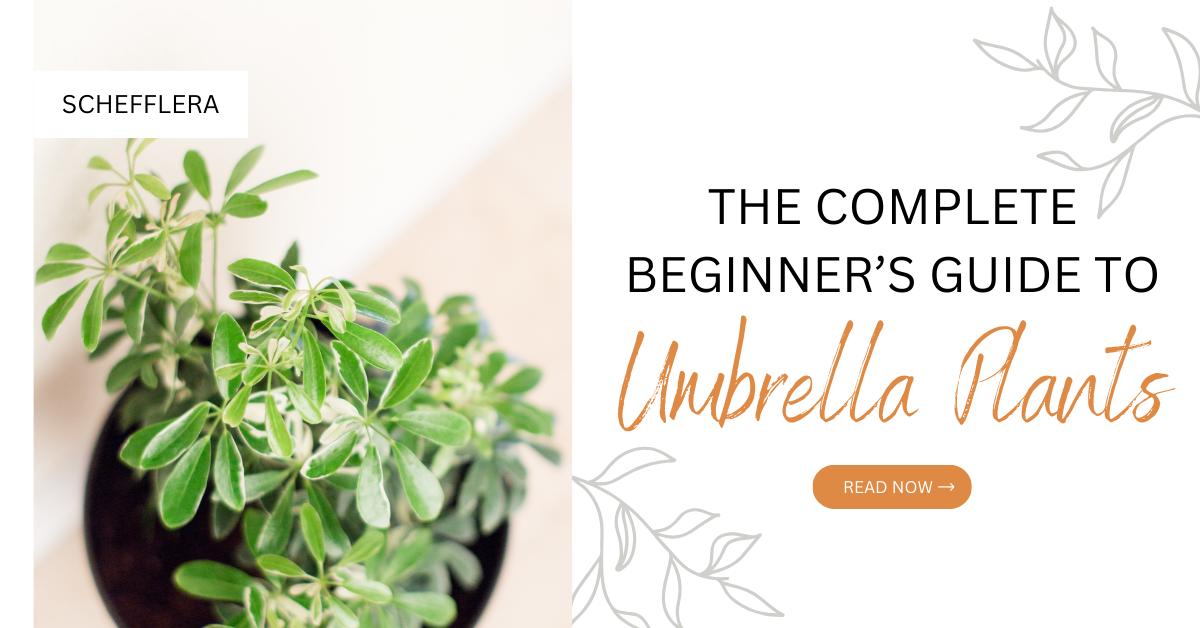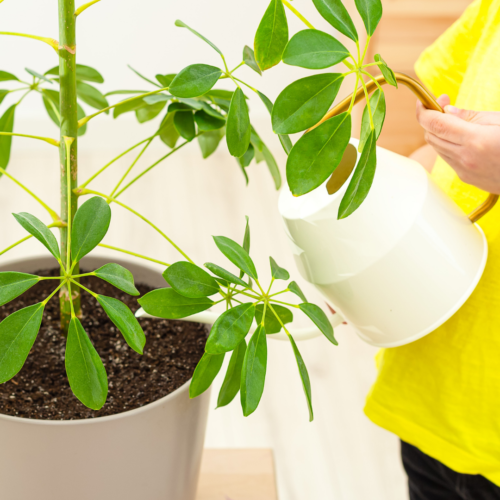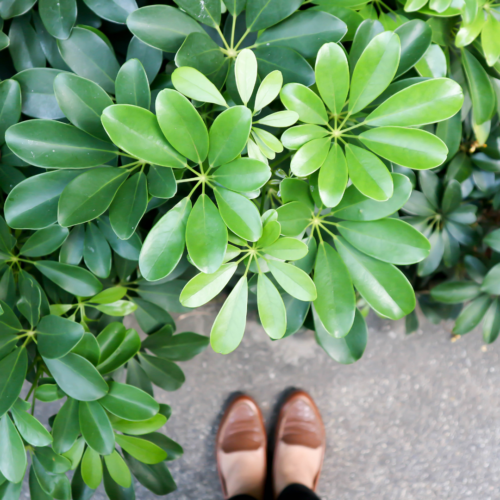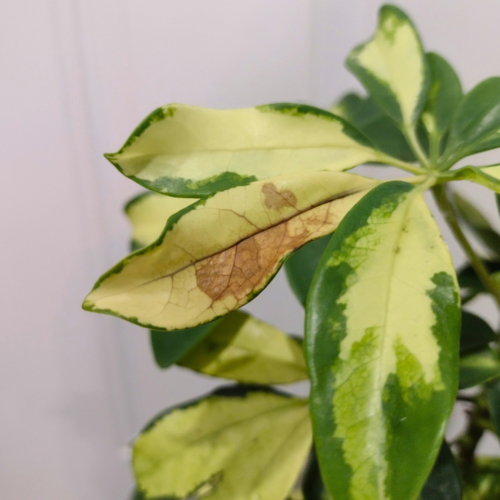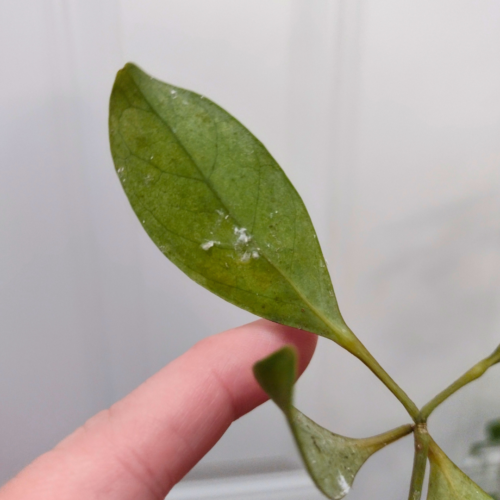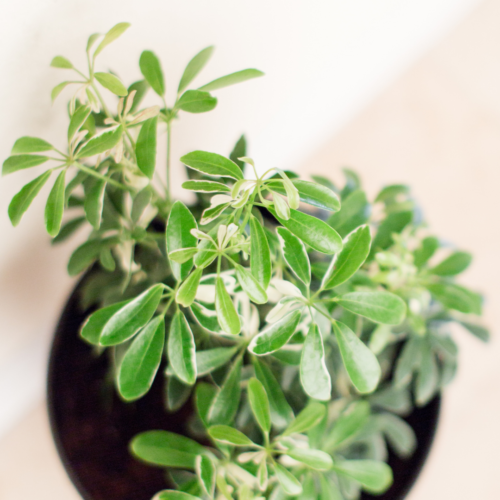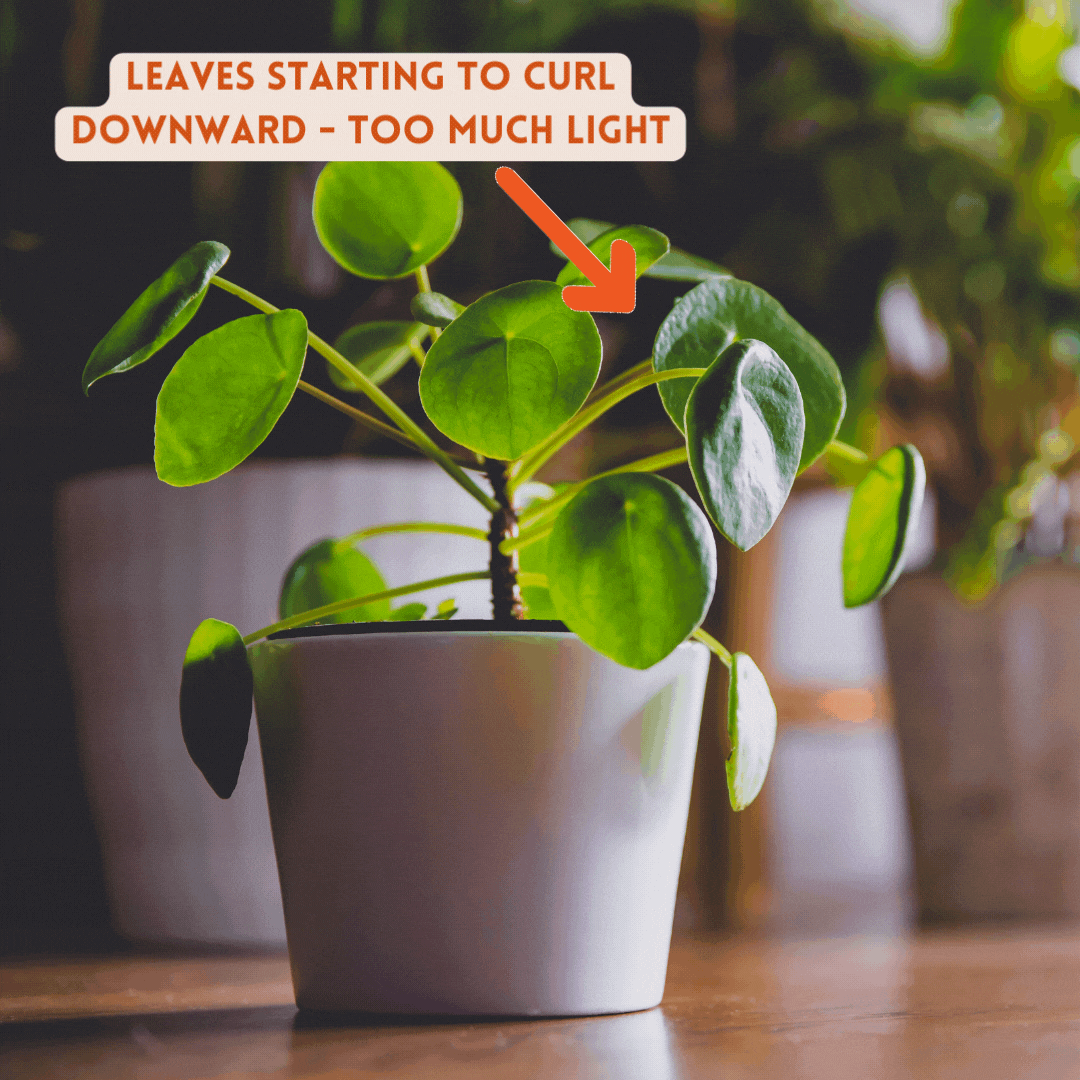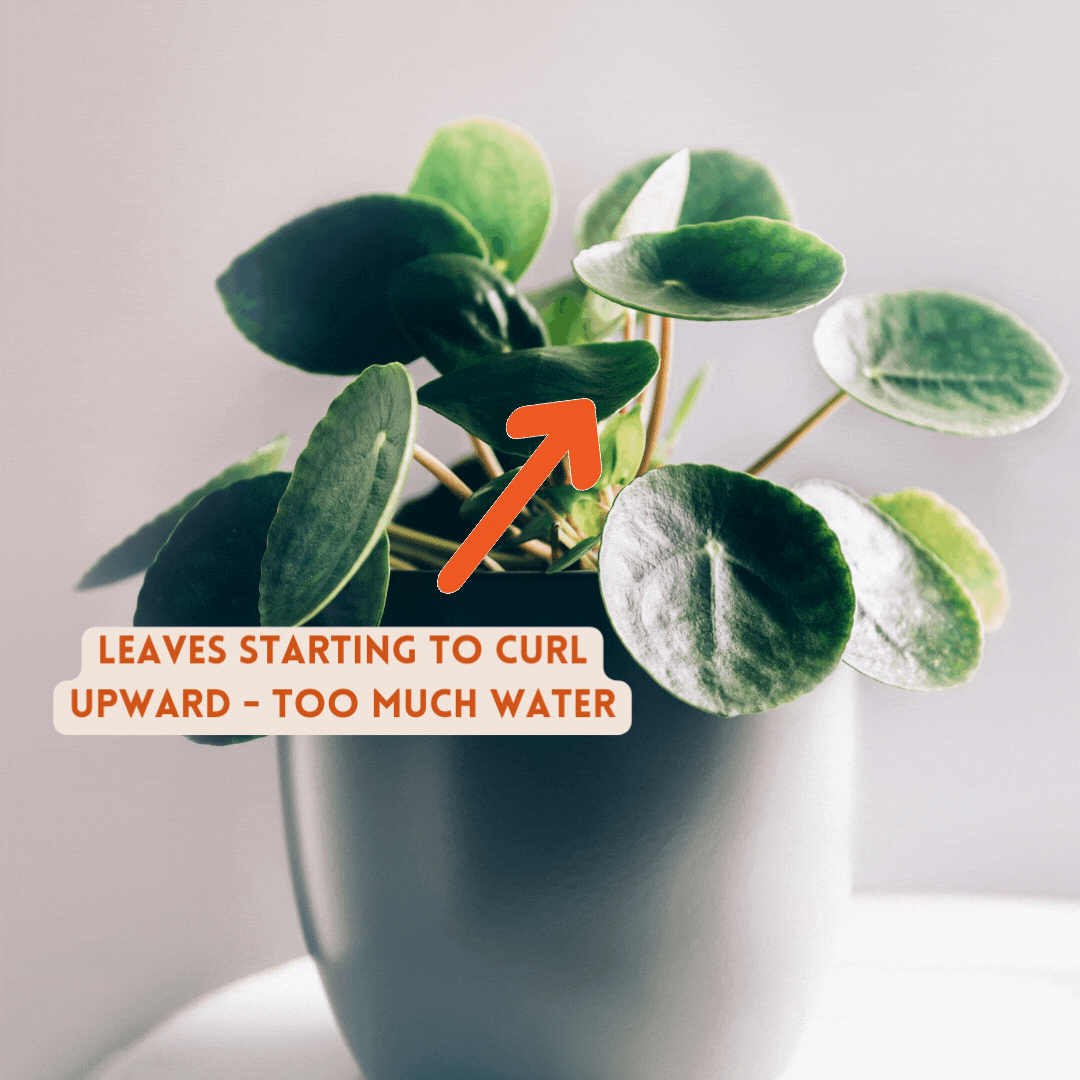Hello succulent lovers! If you’re like me, you can never have enough of these adorable plants in your home. And what’s better than a fuzzy succulent? I’m excited to share with you my top 31 favorite fuzzy succulents that will add a unique and cozy touch to your indoor garden. Whether you’re new to succulents or a seasoned collector, there’s a fuzzy plant out there for everyone. So, let’s dive in and explore these irresistible, tender succulents that will make your heart melt!
What are fuzzy succulent plants?
A fuzzy succulent is a type of plant that exhibits hairy or woolly structures on its leaves or stems, which are often used for water retention and protection from environmental stresses. This characteristic is commonly found in plants belonging to the Crassulaceae, Asteraceae, and Malvaceae families. The fuzzy texture of succulents can range from a light fuzz to dense woolly covering, and can serve as an adaptation to various ecological niches, including arid and high-altitude environments.
These specialized hairy or fuzzy leaves can range in texture from a fine down that is nearly invisible to the naked eye, to a more noticeable fuzziness. You’ll find that touching these plants is an absolute delight, and their fuzzy texture adds a unique dimension to your houseplant collection.
General Care Tips for Fuzzy Succulents
Fuzzy succulents generally require well-draining soil, bright but indirect light, and infrequent watering. They can usually tolerate some direct sunlight, but this is usually not quite as much full sun than their non-fuzzy relatives.
It’s important, though, not to overwater them as their fuzzy leaves can trap moisture among the hairs, which can lead to damage on the leaves and possible root rot. So when watering, make sure to add only a little water, or drain out any excess water from the soil through the pot’s drainage hole.
Then, as with most succulents, fertilizing should be done sparingly, if at all. And only in the summer months. Never fertilize your succulents in the winter months when the plant is not actively growing.
One of the biggest things that sets fuzzy succulent care apart from regular succulents is that fuzzy succulents tend to trap dust on their leaves. Normally this is taken care of outdoors by the wind, but since we typically don’t have high winds indoors, your fuzzy succulents would need to be periodically wiped down with a dry, soft cloth to remove any dust and debris that has gotten stuck on their leaves.
For more succulent care tips, check out my post on Taking Care of Succulents!
*Note: This post may contain affiliate links, which if purchased, I may receive a portion of the profits. This allows me to keep providing awesome information for you!*
1. Kalanchoe tomentosa
Kalanchoe tomentosa, also known as the Panda Plant or Teddy Bear Plant, is a fuzzy succulent that is perfect for plant lovers with furry friends. Its soft, silvery leaves are covered in tiny hairs, giving it a cuddly, teddy bear-like appearance. Not only is it safe for cats, but it also adds a touch of coziness to any space. And, a native of Madagascar, this fun succulent always makes me think of not just a panda bear, but specifically of King Julian from the movie Madagascar! Haha!
Get a Panda Plant!

2. Echeveria Setosa var. Deminuta
Echeveria setosa var. deminuta is a charming succulent with small, fuzzy leaves that resemble tiny sea anemones. This unique plant is known for its rosettes of grayish-green foliage that are covered in fine hairs, adding a touch of softness to its already delicate appearance. Its diminutive size makes it perfect for small spaces or as a feature in a succulent arrangement. It will also easily reward you with a new plant stemming from the sides of each rosette!
Get an Echeveria setosa var. Deminuta!
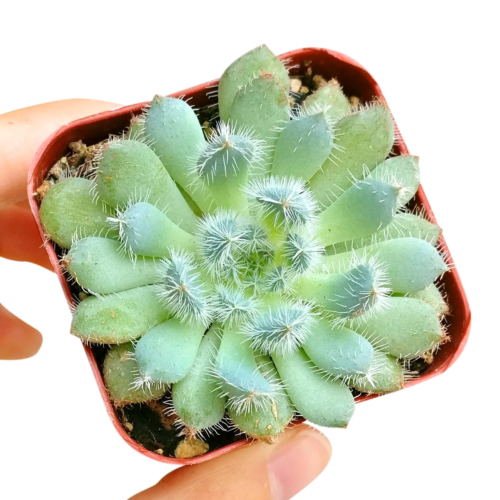
3. Echeveria Doris Taylor
Echeveria Doris Taylor is a stunning succulent with a soft and fuzzy appearance, reminiscent of lamb’s ear. Its rosettes of thick, powdery blue-green leaves are covered in fine white hairs, giving it a cozy and velvety texture. If it is in a bright, warm climate, this slow-growing plant will bloom in late fall or early winter, producing a tall stalk of delicate peach-colored flowers that stand out against its muted foliage.
Get an Echeveria Doris Taylor!

4. Crassula lanuginosa var. Pachystemon ‘David’
Crassula lanuginosa var. pachystemon ‘David’ doesn’t look like your typical jade plants. Instead, its thick, almost bonsai-like trunk and densely packed leaves can cascade down the sides of its pot more like a Burro’s tail succulent. Its fuzzy, silver-green foliage forms a neat, compact rosette that contrasts beautifully with its woody stem. This slow-growing plant is perfect for bonsai enthusiasts or as a statement piece in a succulent arrangement.
Get a David Crassula!
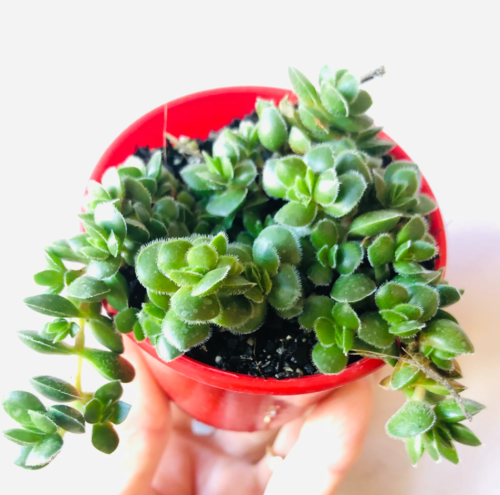
5. Echeveria pulvinata x setosa
Echeveria pulvinata x setosa is a stunning hybrid succulent with a velvety, soft texture and a rosette shape that resembles a flower. Its leaves are covered in fine hairs that give it a fuzzy appearance, with colors ranging from blue-green to reddish-brown. This slow-growing plant produces delicate pink flowers on tall stems in the summer, adding a touch of elegance to its already striking appearance. It’s an excellent addition to any succulent collection or as a unique gift for plant enthusiasts.
Get an Echeveria pulvinata x setosa!
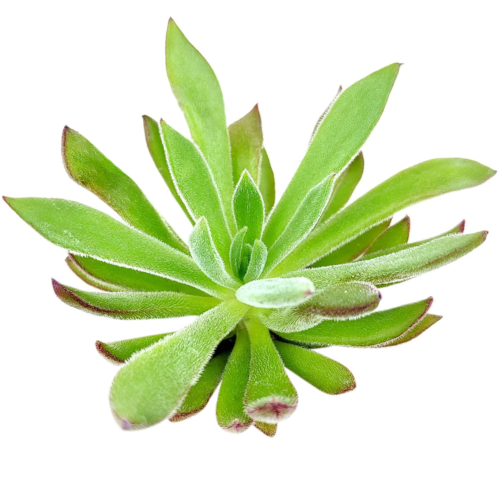
6. Sempervivum Ciliosum
Sempervivum Ciliosum, with the common name of the Eyelash Houseleek, is a charming succulent with a unique appearance that resembles a tiny, green rose. Its compact rosettes of fleshy, pointed leaves have tiny hairs, or “eyelashes,” that protrude from the tips, adding an extra dimension of texture and visual interest. This slow-growing plant produces delicate pink flowers in the summer, making it an excellent addition to any rock garden or succulent arrangement.
Get an Eyelash Houseleek!

7. Crested Echeveria Frosty
Crested Echeveria Frosty is a captivating succulent with a unique and beautiful appearance. Its intricately curved leaves form a rosette shape, which is further accentuated by its crested growth pattern. The frosty blue-green leaves have a powdery texture, adding to its delicate and ethereal appearance. This slow-growing plant blooms in the spring, producing tall stems of peach-colored flowers that stand out against its muted foliage, making it an ideal plant for succulent enthusiasts who appreciate rare and distinctive specimens.
Get a Crested Echeveria Frosty!

8. Aeonium Dinner Plate
Aeonium Dinner Plate is a striking succulent with a unique and eye-catching appearance. Its large, flat rosettes of glossy leaves can grow up to 12 inches in diameter, resembling a plate, hence its name. The leaves range in color from green to deep burgundy and have small hairs along the leaf edges. This slow-growing plant produces tall stems of yellow flowers in the summer, making it a perfect addition to any succulent garden or patio where its striking beauty can be admired by all.
Get an Aeonium Dinner Plate!
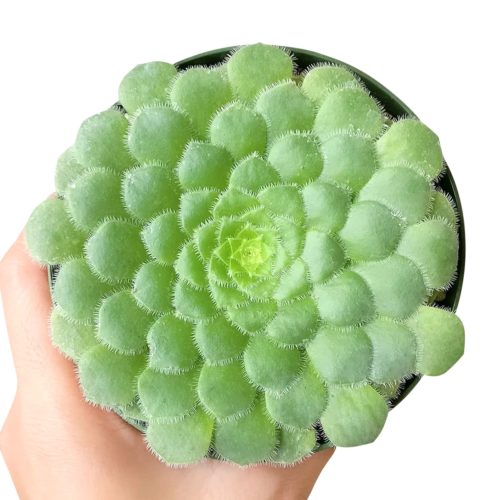
9. Crassula mesembryanthemoides
Crassula mesembryanthemoides is a charming succulent with a unique and fascinating appearance. Its dense clusters of gray-green, hairy leaves form a dense mat-like structure, making it an excellent ground cover plant. The leaves are triangular and pointed, with a powdery texture that gives them a frosted appearance. This slow-growing plant produces small white or pink flowers on tall stems in the summer, adding a delicate touch to its already intriguing look. It’s an excellent addition to any succulent collection or rock garden, bringing a touch of beauty and diversity.
Get yourself a Crassula mesembryanthemhttps://www.etsy.com/listing/1430425188/crassula-mesembryanthemoides?gpla=1&gao=1&oides!
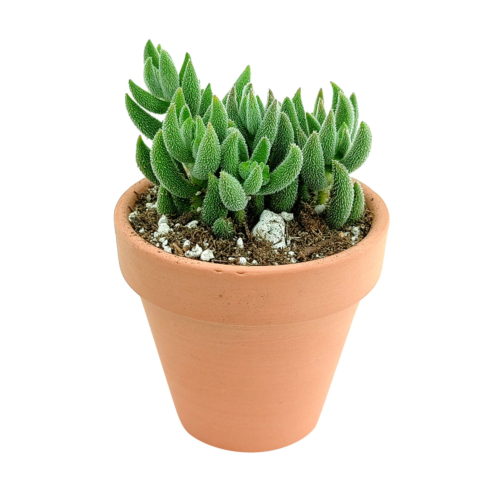
10. Crassula congesta ‘Green Beans”
Crassula congesta ‘Green Beans’ is a delightful succulent with a unique and charming appearance. Its thick, green leaves are shaped like little beans and are tightly packed together in rosettes that can grow up to 6 inches in diameter. The leaves have a fleshy texture and a glossy sheen, on their leaf surface, making them look almost plastic-like. Don’t forget to water it though! This slow-growing plant produces delicate white or pink flowers in the summer. This makes it an excellent addition to any succulent collection or rock garden, especially for those who appreciate rare and unusual specimens.
Get yourself a Green Bean Crassula!
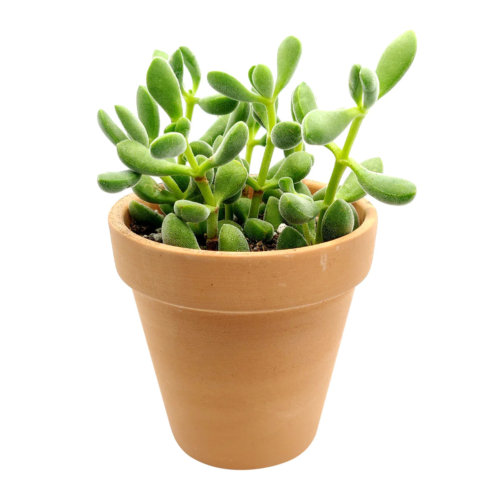
11. Kalanchoe orgyalis
Kalanchoe orgyalis is one of my favorite succulents. It has a unique appearance with elongated, fuzzy, and copper-colored leaves that look almost like they’re made of velvet. The leaves’ edges have a smooth texture that adds to the plant’s charm. This slow-growing succulent produces clusters of delicate pink flowers that add a pop of color to its already striking appearance. It’s an excellent addition to any succulent collection, and the fuzziness of the leaves makes it a favorite of mine to touch and admire.
Get a Kalanchoe orgyalis!

12. Echinopsis subdenudata ‘Fuzzy Navel’
Echinopsis subdenudata ‘Fuzzy Navel’ is a unique and fascinating succulent that I can’t help but love. Its round, green body is covered in tiny white spines that make it look fuzzy and almost soft to the touch. The plant’s spines make it unique and fascinating, and its slow growth rate makes it a perfect choice for indoor gardening. The plant produces large, showy pink flowers that add to its already attractive look. Whether placed on a windowsill or in a terrarium, ‘Fuzzy Navel’ is an excellent addition to any indoor succulent collection.
Get yourself a Fuzzy Navel succulent!

13. Cotyledon Tomentosa – Bear Paw
Cotyledon Tomentosa, also known as the Bear’s Paw, is a delightful succulent with a unique appearance resembling the paw of a bear. Its rounded, furry leaves are covered in tiny hairs, and the tips are adorned with sharp, claw-like protrusions. This slow-growing plant produces delicate, tubular flowers in shades of orange or yellow in the summer, adding a touch of color to its already charming appearance. It’s an excellent addition to any succulent collection, especially for those who love animals.
Get yourself a Bear Paw!
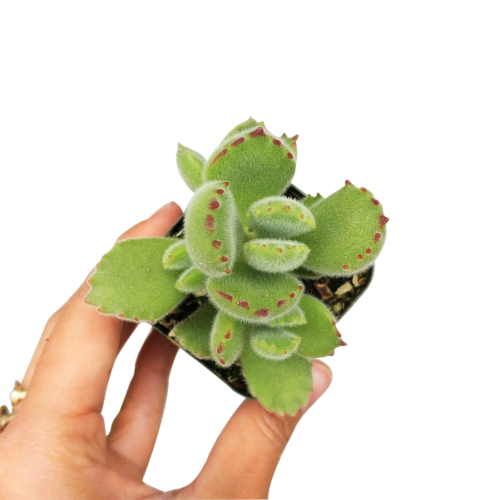
14. Crassula brevifolia
Crassula brevifolia is a perfect succulent for an indoor setting. Its round, fuzzy leaves grow in a rosette pattern that adds a unique and charming touch to any room. The plant’s thick leaves have a soft texture that invites you to touch them, and they’re easy to care for, making them a great choice for indoor gardening. This succulent thrives in bright, indirect sunlight and requires infrequent watering. It’s an excellent addition to any indoor succulent collection, adding a touch of greenery and coziness to your living space.
Get a Crassula brevifolia!

15. Kalanchoe eriophylla
Kalanchoe eriophylla is a unique and fascinating succulent that can add a charming touch to any indoor space. Its velvety, fuzzy leaves give it a soft and cozy appearance that invites you to touch them. The plant is easy to care for, making it an excellent choice for indoor gardening, and it produces beautiful pink showy flowers that add to its already attractive look. This succulent is perfect for adding a pop of color and texture to your indoor succulent collection while keeping your furry friends safe.
Get yourself a Kalanchoe eriophylla!

16. Crassula mesembryanthemoides ‘Tenelli’
Crassula mesembryanthemoides Tenelli is an excellent choice for an indoor succulent collection. The plant’s delicate, fuzzy leaves give it a soft and cozy appearance that adds warmth to any room. It’s easy to care for and doesn’t require frequent watering, making it a low-maintenance choice for indoor gardening. Its compact size and attractive look make it perfect for tabletops or shelves, adding a touch of greenery and elegance to your indoor space.
Get a Tenelli Crassula!
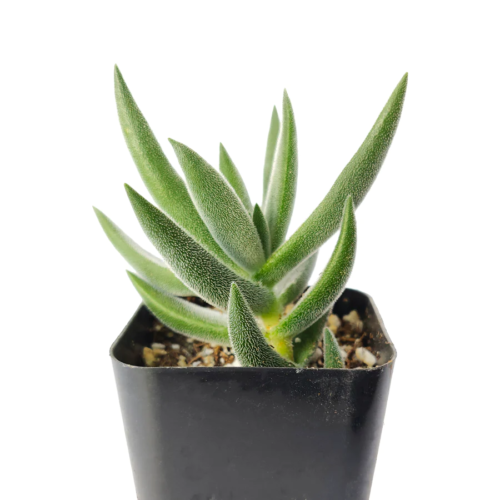
17. Sempervivum Cobweb Hens and Chicks
Sempervivum Cobweb Hens and Chicks is a delightful indoor succulent that adds texture and visual interest to any room. Its web-like fuzziness and small rosette-shaped fleshy leaves make it a unique and attractive addition to your indoor garden. This low-maintenance plant thrives in bright light and doesn’t require frequent watering, making it perfect for busy plant parents. Plus, its pet-safe nature ensures that your furry friends won’t be harmed if they decide to give it a nibble.
Get yourself a Cobweb Hens and Chicks!

18. Kalanchoe tomentosa – Variegated Bear Paw
The Variegated Bear Paw kalanchoe is a striking addition to any indoor collection. Its soft, fuzzy leaves are variegated with cream and green, creating a beautiful contrast. Unlike the original Bear Paw Succulent, this variety has more of a trailing growth habit and can be a great choice for hanging baskets. It’s safe for pets and easy to care for, making it a perfect option for any indoor plant lover.
Grab a Variegated Bear Paw!

19. Senecio haworthii – Woolly Senecio
The Senecio haworthii, also known as the Woolly Senecio or the Woolly Rose, is a soft, fuzzy succulent that adds a playful touch to any indoor space. Unlike its famous cousin, the string of pearls, this plant has fuzzy, grey-green leaves that are irresistible to touch and pet. This makes it a great addition for anyone who loves tactile plants. Plus, this low-maintenance succulent is perfect for busy plant parents looking for a bit of greenery without the hassle!
Get yourself a Woolly senecio!
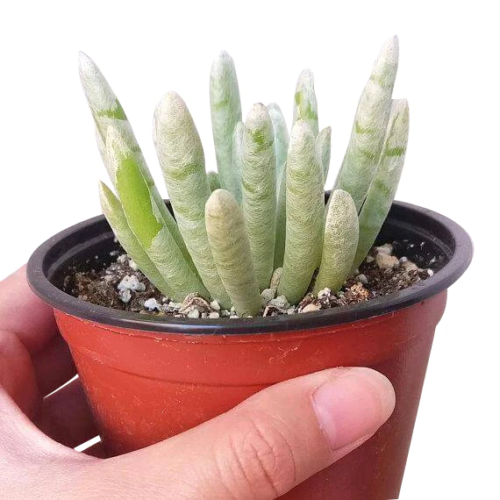
20. Cephalocereus senilis – Old Man Cactus
Old Man Cactus, with its shaggy white hairs, is a charming addition to any succulent collection. Its soft and fuzzy texture adds a cozy touch to your indoor space. This plant requires minimal care and can tolerate a variety of indoor conditions, making it an easy choice for any level of plant enthusiast. Its unique appearance is sure to bring a smile to your face every time you see it.
Get an Old Man Cactus!

21. Cyanotis somaliensis – Kitten Ears
Kitten Ears, or Cyanotis somaliensis, is a delightful succulent species that boasts a soft and fuzzy texture reminiscent of a soft, furry kitten’s ears. The plant’s delicate green leaves are adorned with tiny white hairs that give it a cozy and inviting appearance. It’s a perfect addition to any indoor garden or plant collection, adding a touch of charm and playfulness.
Get yourself some Kitten Ears!
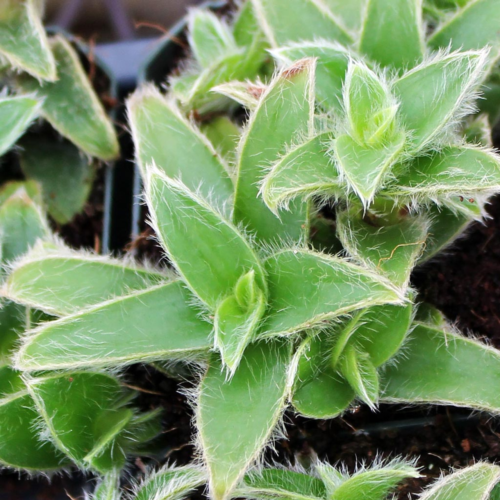
22. Kalanchoe tomentosa ‘Chocolate soldier’
This succulent is a Chocolate Soldier, a type of Kalanchoe tomentosa. Its fuzzy, chocolate-brown leaves give it a unique appearance that I can’t resist touching. The main difference between the regular panda plant and the Chocolate Soldier plants is the color of the hairs on the leaves. While the original has green and white fuzzy succulent leaves, the Chocolate Soldier leaves have a more distinct brown hair color, which makes the leaves look more like chocolate… yummm!
Get a Chocolate Soldier!

23. Echeveria pulvinata var. Frigida – White Chenille Plant
Oh, the White Chenille Plant, also known as Echeveria pulvinata var. Frigida, is one of my favorite indoor succulents. The fuzzy leaves are irresistible to touch and the plant’s rosette shape is just adorable. Plus, its fuzzy leaves resemble white hairs, and the rosettes form small clumps that make it look like a cute little snowball. This plant thrives in bright light and is easy to care for, making it perfect for succulent beginners.
Get yourself a White Chenille Plant!

24. Kalanchoe beharensis ‘Fang’
Kalanchoe beharensis, also known as the Felt Bush or Velvet Leaf Kalanchoe, is a unique and fuzzy succulent that is perfect for any indoor plant collection. The leaves are covered in soft, felt-like hairs that make them a pleasure to touch. The silver-green leaves have a scalloped edge and are held on tall, upright stems. Then, with the right care, you could possibly see stalks of delicate pink or white flowers blooming from the head of the plant. This makes it a beautiful addition to any succulent collection!
Get a Velvet Leaf Kalanchoe!

25. Echeveria setosa – Mexican Firecracker
Looking for a striking, low-maintenance succulent to add to your indoor collection? Look no further than Echeveria setosa, also known as the Mexican Firecracker. This beautiful plant boasts a unique fuzzy texture and bright red-orange tips, adding a pop of color to any space.
Grab yourself a Mexican Firecracker!

26. Tradescantia sillamontana
If you’re looking for a succulent with a unique texture, you should check out the Tradescantia sillamontana, also known as Cobweb Spiderwort. This plant’s fuzzy, silver leaves give it an almost velvety appearance. It’s definitely a conversation starter, and I love the way it adds a touch of softness to any indoor succulent garden. Just be aware, this can be a picky succulent to grow indoors as it loves lots of humidity!
Grab yourself a tradescantia sillamontana!

27. Adromischus cristatus – Key Lime Pie Plant
The Adromischus cristatus, also known as the Crinkle leaf plant or Key Lime Pie plant, has a unique crinkly texture to its leaves that almost looks like it’s been scrunched up like paper. The fuzziness of the leaves makes it all the more interesting to touch and care for. Its vibrant green color and wavy shape give it a playful, fun appearance that’s sure to brighten up any room.
Buy yourself a Key Lime Pie plant!

28. Aeonium smithii
Aeonium smithii, or the Black Rose, is a beautiful succulent with dark, glossy leaves that almost look black. It’s a bit fuzzy to the touch and adds a nice rosette form to your indoor garden. With proper care, this plant can grow tall and produce stunning rosettes of flowers at the top of the stem. It can be grown indoors as well as outdoors in warmer climates, and is a low maintenance plant that will thrive in a sunny spot with well-draining soil. When exposed to more sun, the red pigmentation in its leaves becomes more vibrant, making it a stunning addition to any succulent collection.
Get yourself a Black Rose Aeonium!

29. Echeveria setosa var. Ciliata
Echeveria setosa var. ciliata is a fuzzy, succulent plant with a unique appearance. Its leaves have hair-like growths that give it a distinct texture, and its pale green color adds to its overall beauty. I love the way it looks in a decorative pot or mixed with other succulents in an arrangement!
Get yourself an Echeveria setosa var. ciliata!
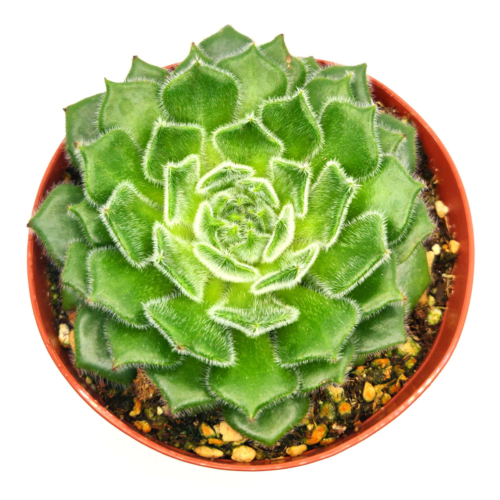
30. Crassula barbata
Crassula barbata, also known as the Bearded-leaved Crassula, is a unique succulent with plump, triangular leaves that are a pale green color. The leaves have a slightly fuzzy texture, which makes this plant all the more charming. This Crassula is a native of South Africa, and as such is a slow grower. But it’s definitely worth the wait for its beautiful rose shape and unique texture.
Get a Bearded-leaved Crassula!
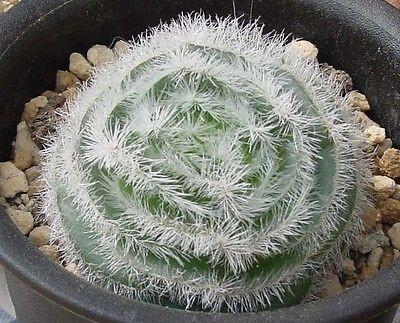
31. Echeveria harmsii
Echeveria harmsii is a delightful succulent with a unique appearance. Its leaves are a dusty blue-green color with a soft velvety texture that is so satisfying to touch. The fuzzy leaves have a striking white outline, and the rosette shape makes it perfect for display in a pot or hanging basket.
Get yourself an Echeveria harmsii!
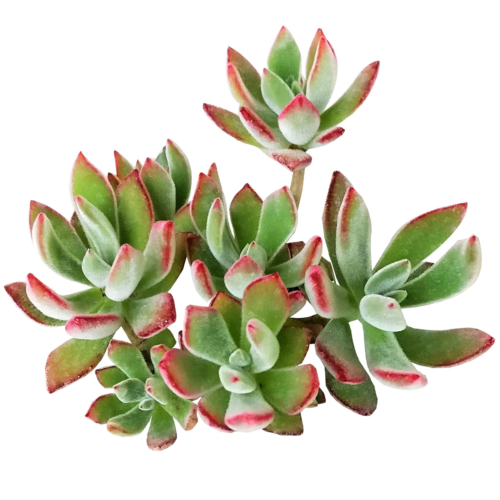
I hope this list of 31 fuzzy succulents for indoors has inspired you to add some texture and variety to your indoor plant collection. Remember to always research the specific care requirements for each plant and provide them with the appropriate environment to thrive. With a little bit of love and attention, these fuzzy succulents can brighten up your home and bring you joy and fuzzy feelings for years to come!
Happy Digging!

